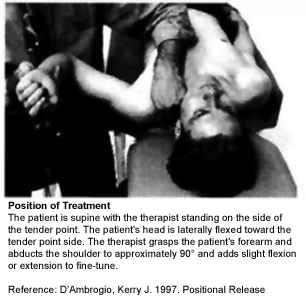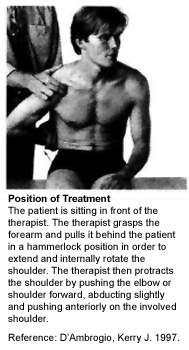|
When Modalities
Are Not An Option
|
Ann
is a 74-year-old female who presented in our office with severe muscle
spasms in the posterior left shoulder and paraspinal region. The muscle
spasm started 10 days earlier after having a pacemaker implanted in her left
anterior subclavian region. The cardiologist who performed Ann’s surgery
instructed her not to move the left shoulder or arm above shoulder height.
She also was not to push, pull, or lift for two weeks until the leads from
the pacemaker were secured and the surgery site had healed.
The doctor’s only treatment for the muscle spasms was pain killers and
muscle relaxant medication. This did not provide any lasting relief to Ann.
We had seen Ann several years earlier after she had a knee replacement. We
helped her with post-op recovery and rehab. This is why she returned to our
clinic following her pacemaker surgery.
We started by having Ann fill out a thorough health history. We then
conducted a full evaluation using A.R.T.S. This stands for Asymmetry, Range
of Motion, Tissue Tenderness, and Special Tests.
The asymmetry in Ann’s posture on evaluation revealed a forward head posture
and an anterior elevated left shoulder. The range of motion in her left
shoulder was limited to 45 percent of normal flexion and 30 percent of
normal abduction with an empty end-feel. Her range of motion was very
antalgic. Antalgic ROM means she was afraid to move her shoulder because it
would cause greater spasm and pain if she moved it in excess. She was unable
to put her shirt on over her head, wash her hair, or use her left arm to
secure her seat belt.
Tissue tenderness tests found tender points in Ann’s left trapezius and left
pectoralis minor. Her trapezius tender point was an 8 on a scale of 0–10—10
being extremely tender and painful, and 0 being not painful at all. Her
pectoralis minor pain was a 7/10. When we evaluated for tender points on her
posterior shoulder, where she was complaining of pain, the area of greatest
tenderness was a 5/10 in the left rhomboid region. She was surprised that
the muscles in the back of her shoulder were not more tender to the touch
when we evaluated her.
We did not need to perform any special tests with Ann after discovering the
muscle spasms and tender points in her shoulder. The rest of her evaluation
was unremarkable.
Since Ann was only 10 days post-op from having a pacemaker implanted, we
were not able to do a lot of active therapies that could possibly disturb
the leads to the pacemaker. Electrical stimulation also was contraindicated
with her new pacemaker. A passive, indirect technique called Muscle
Balancing or Positional Release Therapy was therefore the best approach to
use to relieve Ann’s muscle spasms. A passive therapy means the patient does
not initiate the movement during the treatment. An indirect technique is one
that takes the body into a position of comfort, away from the barrier or
pain.
Applying Muscle Balancing protocols, we treated the most severe tender point
first by putting Ann in the position of comfort. (See example below.)

After this primary tender point was treated for approximately 90 seconds,
the point was re-assessed. The pain was 0/10 after just one treatment. We
went on to re-assess the pectoralis minor tender point and found that it had
subsided to a 5/10 tenderness. By identifying and treating the primary
tender point first, the secondary point started to subside.
We treated the pectoralis minor tender point with an indirect procedure.
(See example below.) We were able to treat lateral to Ann’s pacemaker to
perform this treatment, and did not disturb the surgery site.

Ann’s pain level on this tender point went from 5/10 to 0/10 in about two
minutes. When we re-assessed Ann’s posterior shoulder, her spasms and pain
had dissipated completely without having to treat this area. Using Muscle
Balancing we stopped the inappropriate proprioceptor activity and restored
her neuromuscular system to homeostasis.
When modality therapies are not an option for treating muscle spasms, manual
therapy techniques such as Muscle Balancing/Positional Release Therapy are a
very effective protocol to use in the clinic.
Last revised: September 18, 2014
by Dr. Kerry D’Ambrogio, D.O.M., A.P., P.T., D.O.-M.T.P.
 Kerry
D’Ambrogio is a physical therapist, osteopath and
board-certified acupuncture physician. He is the president
and director of the D’Ambrogio Institute and Therapeutic
Systems, Inc., in Sarasota, Fla. He is the co-author of
Positional Release Therapy (Mosby). D’Ambrogio is a
graduate of the physical therapy program at the University
of Toronto (Canada), the osteopathic program at the Canadian
Academy of Osteopathy (Hamilton, Ont.), the John Wernham
College of Classical Osteopathy (Maidstone, England), and
the acupuncture program at the Academy of Chinese Healing
Arts (Sarasota, Fla.).
Kerry
D’Ambrogio is a physical therapist, osteopath and
board-certified acupuncture physician. He is the president
and director of the D’Ambrogio Institute and Therapeutic
Systems, Inc., in Sarasota, Fla. He is the co-author of
Positional Release Therapy (Mosby). D’Ambrogio is a
graduate of the physical therapy program at the University
of Toronto (Canada), the osteopathic program at the Canadian
Academy of Osteopathy (Hamilton, Ont.), the John Wernham
College of Classical Osteopathy (Maidstone, England), and
the acupuncture program at the Academy of Chinese Healing
Arts (Sarasota, Fla.).






